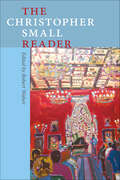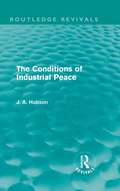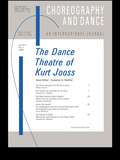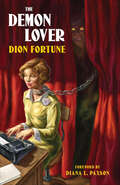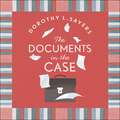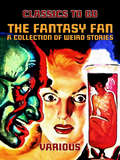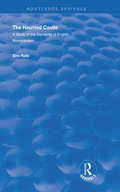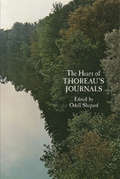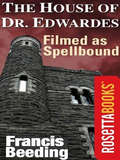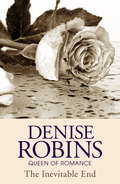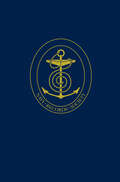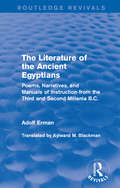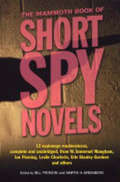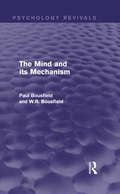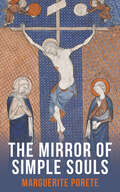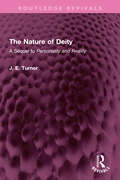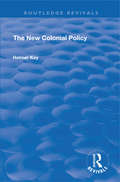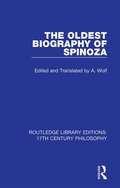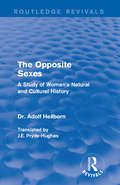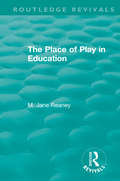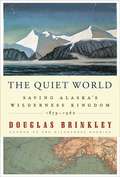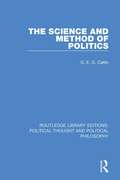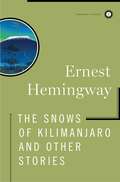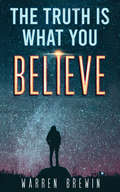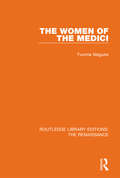- Table View
- List View
The Christopher Small Reader (Music/culture Ser.)
by Christopher SmallThe Christopher Small Reader is the fourth and final book in Christopher Small's legacy as a composer, pianist, teacher, friend, provocateur, and influential outsider in classical music studies. It is at once a compendium of, a complement to, and an important addition to Small's prior books: Musicking; Music, Society, Education; and Music of the Common Tongue. The Christopher Small Reader brings previously published work, some of it available in disparate locations, together with key excerpts from his three books, and other writings that remained unpublished at his passing in 2011, making available ideas that were not included in the earlier books and presenting an overview of his thought over the course of his life. The collection is a fitting capstone, providing rich insights into Small's understanding of musicking as a crucial way of relating to the world.Hardcover is un-jacketed.
The Conditions of Industrial Peace (Routledge Revivals)
by J. A. HobsonFirst published in 1927, Hobson’s treatise on industrial conflict analyses the nature and causes of industrial disputes with the aim of finding an equitable means of settling them. Assessing the notion of a fair wage within the context of the pool of wealth, Hobson sets about creating a peace policy for industry. Set against the backdrop of economic downturn and struggle in the interwar years, in the years preceding the great depression, this is work of social, historical and economic interest.
The Dance Theatre of Kurt Jooss
by Suzanne WaltherFirst Published in 1997. Routledge is an imprint of Taylor & Francis, an informa company.
The Demon Lover
by Dion FortuneA secretary finds herself psychically bound to her boss in this supernatural thriller from one of the leading luminaries of twenieth-century esoteric thought.The Demon Lover was first published in 1927, the same year as H.P. Lovecraft’s The Call of Cthulhu. Dion Fortune was among a generation of occult horror writers that formed popular culture’s obsession with secret societies, vampires, demons, ritual magic, and dark powers lurking in the shadows. What sets Fortune apart from so many of her contemporaries is her deep knowledge of the inner workings of magical orders, rites, and practices, and her own freethinking on occult subjects, demonstrated in the classic Psychic Self-Defense and The Mystical Qabalah.When young Veronica Mainwaring is hired by Justin Lucas as his secretary, she has no idea that she will soon find herself being used as his own personal trance medium. With an invisible collar keeping her bound to Lucas, her every attempt at escape is foiled by a yank on the unseen chain. Veronica soon finds herself trapped in Lucas’ quest for power and knowledge beyond the earthly plane as a story of past lives, hidden evils, and a twisted love affair come to life in this occult thriller.“A convincingly unsettling book. Fortune evokes a world of powers that can threaten you; that are both part of a coherent moral mythology, and also cloaked in mystery. Things are unpredictable, though there is an order to them . . . It’s not a book for every taste, maybe. But it’s worth a look, for a distinctive handling of magic and its overlap with the everyday world.” —Black Gate
The Documents in the Case
by Dorothy L SayersThe bed was broken and tilted grotesquely sideways. Harrison was sprawled over in a huddle of soiled blankets. His mouth was twisted . . .Harrison had been an expert on deadly mushrooms. How was it then that he had eaten a large quantity of death-dealing muscarine? Was it an accident? Suicide? Or murder?The documents in the case seemed to be a simple collection of love notes and letters home. But they concealed a clue to the brilliant murderer who baffled the best minds in London.'She combined literary prose with powerful suspense, and it takes a rare talent to achieve that. A truly great storyteller.' Minette Walters(P)2015 Hodder & Stoughton
The Fantasy Fan A Collection of Weird Stories (Classics To Go)
by VariousThe Fantasy Fan was the first fan magazine in the weird fiction field and therefore holds an important place in the history of the American fantasy and horror fiction pulp magazine. Issued monthly, it was first published in September 1933, and discontinued 18 issues later in February 1935. The magazine was edited by Charles Hornig (25 May 1916 - 11 October 1999).
The Haunted Castle: A Study of the Elements of English Romanticism (Routledge Revivals)
by Eino RailoPublished in 1927: The purpose of the present work is consequently to serve as a guide to English horror-romanticism and by presenting the chief materials used by it and grouping them according to the various themes employed, to show how the main romantic movement that began at the turn of the century and is represented in all shorter expositions of the subject as a suddenly bursting wave, as a kid of spontaneous revolution, is in all essentials the outcome of an organic development with widely spread roots that penetrate deep into the past.
The Heart of Thoreau's Journals
by Odell ShepardThe conflict between scientific observation and poetry, reflections on abolition, transcendental philosophy, other concerns are explored in this superb general selection from Thoreau's voluminous Journal. Here are "...the choicest fruits of Thoreau..." -- Nation.
The House of Dr. Edwardes
by Francis BeedingA novel of psychological terror set in a mental asylum that became the basis for Alfred Hitchcock&’s Spellbound starring Ingrid Bergman and Gregory Peck. From the outset, the air that Beeding&’s characters breathe crackles with ominous electricity. This is surely what appealed to Alfred Hitchcock when he found Beeding&’s The House of Dr. Edwardes and used it as the inspiration for his unforgettable film Spellbound. The &“house&” of the title is a lunatic asylum in France and Dr. Edwardes is the head psychiatrist. While Edwardes is held in high esteem, an almost iconic figure in psychiatric circles, there is something clearly amiss. The novel opens with a puzzling, ominous episode in which a patient being transported to the asylum grows agitated as the car bringing him there approaches. The patiently suddenly screams: &“the gorge of the devil&” and then attacks and kills one of the supervisors, a promising but inexperienced psychiatrist. This opens a position that Dr. Sedgwick accepts, but on arrival, she learns that Dr. Edwardes has taken a leave of absence to calm his nerves. It doesn&’t take her long to discover that the house is hardly in order. Unlike Hitchcock&’s Spellbound, The House of Dr. Edwardes owes less to Freud, displaying much closer affinities with the brooding, psychological landscapes of Gothic novels of the eighteenth and nineteenth centuries, particularly Emily Brontë&’s Wuthering Heights. The result is a compelling work—part mystery, part modern Gothic.
The Inevitable End
by Denise RobinsBillie Carden is one of the new breed of women: tomboyish and defiantlyindependent, she has no use for men and no desire to marry. Nor does sheneed to - for she is the lucky heiress to the fortune of her AmericanUncle Silas.But Billie's life takes a whole new direction when two events - at firstunconnected - conspire to thwart her plans; an encounter with theimpoverished Richard Bromley, and a dramatic ultimatum from her uncle.A captivating love story from the 100-million-copy bestselling Queen ofRomance, first published in 1927, and available now for the first timein eBook.
The Keith Papers: Vol. I
by W.G. PerrinGeorge Keith Elphinstone, Lord Keith (1746-1823) was a Scottish naval officer who entered the navy as a penurious midshipman towards the end of the Seven Years War. He had a long career at sea, during which he missed taking part in any major battle, but held major commands throughout the Revolutionary and Napoleonic Wars (except 1807-1812). He is chiefly known for his skill in commanding very large fleets, often spread over a very wide area, and for the consequent prize money which made him the richest naval officer of his day. He also gained a reputation for being very keen on acquring it. These three volumes only represent a small fraction of the documents in Keith’s very large personal collection of letter and order books and loose documents in the National Maritime Museum, which occupies 124 foot of shelf space. The first document in this volume is dated 1771, and the first half covers Keith’s career as a promising captain in the American Revolutionary War. He took part in the operations off Florida in 1778 and at the capture of Charleston in 1780 in which he distinguished himself by his navigational skill, and by good relations with the army, which was to mark the rest of his career. The second part of the volume deals with Keith’s role in the occupation of Toulon in 1793, a small section of Lord Howe’s tactical memoranda in 1793-4, but the greater part is devoted to the operation which first bought Keith to the attention of the British public, the capture of the Cape of Good Hope from the Dutch in 1795-6.
The Literature of the Ancient Egyptians: Poems, Narratives, and Manuals of Instruction from the Third and Second Millenia B.C. (Routledge Revivals)
by Adolf ErmanOriginally published in 1927, this text contains a translation of Adolf Erman’s work into English. Erman’s original intention was to bring the songs, stories and poems that have survived from ancient Egypt to the masses of the modern world. The literature of the Egyptian world provides a real insight into the day-to-day life of one of the oldest societies known to man and this translation ensures that these insights are afforded to an English audience. This title will be of interest to students of History, Classics and Literature.
The Mammoth Book of Short Spy Novels (Mammoth Books #414)
by Martin Greenberg Bill PronziniSpanning more than 75 years of espionage writing in USA and the UK, here are gripping tales by classic writers in the field including W. Somerset Maugham, Ian Fleming, Leslie Charteris, and Erle Stanley Gardner. They are presented complete and unabridged. Among the now legendary fictional secret agents, counterspies and double agents featured are Somerset Maugham's enigmatic operative Ashenden; Ian Fleming's legendary 007; and Peter O'Donnell's Modesty Blaise, 'the female James Bond'. The stories include: The formula for a deadly warfare chemical propels secret agent Peter Baron on a mission through Italy - in Deep Sleep by Bruce Cassiday Agent 007 James Bond confronts military intrigue in the Caribbean - in Octopussy, by Ian Fleming International conspiracy, assassination, bombs, plot and counter-plot in Washington D.C. - in Dealers in Doom by William E. Barrett Someone is out to destroy the British Government, from the inside - in The Spoilers, by Michael Gilbert The CIA enlists a small-town policeman to track down a spy who will stop at nothing to preserve his identity - in The People of the Peacock, by Edward D. Hoch
The Mind and its Mechanism (Psychology Revivals)
by W.R. Bousfield Paul BousfieldFirst published in 1927, the original blurb reads: "Scientists are beginning to believe there is some immaterial thing which performs certain functions that the material mechanism of the brain is powerless to perform. It is the purpose of this book to explain what that immaterial thing is and how it functions. The Mind and Its Mechanism deals with a theory that may conceivably influence the study of psychology, and will interest not only psychologists, but physiologists, physicists and biologists." Now back in print, this title can be read and enjoyed in its historical context.
The Mirror of Simple Souls
by Marguerite PoreteDive into the profound depths of Christian spiritualism with The Mirror of Simple Souls, an early 14th-century work by Marguerite Porete. It's exploration of Oneness with God, though influential at the time of its writing, was denounced by Church authorities as heretical and banned for its supposed connection to Antinomianism. Since it's attribution to Porete in the 1940's, The Mirror of Simple Souls has come to be regarded as among the most important works of medieval Christian mysticism.
The Nature of Deity: A Sequel to 'Personality and Reality' (Routledge Revivals)
by J. E. TurnerFirst published in 1927, The Nature of Deity forms a sequel to Personality and Reality. The premise of this book is the conclusion of the prequel: that there exists a Supreme Self or Deity. In pursuing this argument, the author uses logic and broad facts that prove the existence of a Supreme Self. This book will be of interest to students of philosophy, religion, literature and science.
The New Colonial Policy (Routledge Revivals)
by Helmer KeyPublished in 1922, this book provides a history of the era as well as making reference to Britain’s colonial past. Egerton discusses British policies in her territories, as well as trials and tribulations that faced the British Empires influence at the dawn of the twentieth century.
The Oldest Biography of Spinoza (Routledge Library Editions: 17th Century Philosophy)
by A. WolfOriginally published in 1927, the publication of this volume may be regarded as a fitting contribution to the international celebrations in memory of one of the greatest of the sons of men. This biography is the oldest, and it is the only one written by one who knew Spinoza personally, and loved him well.
The Opposite Sexes: A Study of Woman's Natural and Cultural History (Routledge Revivals)
by Dr. Adolf HeilbornOriginally published in English in 1927, this study discusses the physical differences between men and women and how this affected the views of men and women of society. With all known information at the time, the author also details perceived mental differences between the sexes and finishes with a brief cultural history of women’s place in society. This title will be of interest to students of Gender Studies and History.
The Place of Play in Education (Routledge Revivals)
by M. Jane ReaneyOriginally published in 1927, this was a book written specially for teachers and parents, based upon the writer’s practical experience and research. It deals with the fundamental importance of play in the child’s development and as a basis for all education. A set of 74 games, arranged by Miss Amy Whateley, is appended, in four groups according to the four play periods of childhood. Today it can be read and enjoyed in its historical context.
The Quiet World: Saving Alaska's Wilderness Kingdom, 1879-1960
by Douglas BrinkleyA riveting history of America's most beautiful natural resources, The Quiet World documents the heroic fight waged by the U.S. federal government from 1879 to 1960 to save wild Alaska--Mount McKinley, the Tongass and Chugach national forests, Gates of the Arctic, Glacier Bay, Lake Clark, and the Coastal Plain of the Beaufort Sea, among other treasured landscapes--from the extraction industries. Award-winning historian Douglas Brinkley traces the wilderness movement in Alaska, from John Muir to Theodore Roosevelt to Aldo Leopold to Dwight D. Eisenhower, with narrative verve. Basing his research on extensive new archival material, Brinkley shows how a colorful band of determined environmentalists created the Arctic National Wildlife Refuge just before John F. Kennedy became president. Brinkley introduces a lively gallery of characters influential in preserving Alaska's wilderness resources: the indomitable U.S. Supreme Court justice William O. Douglas, who championed the Brooks Range; charming Ivy League explorer Charles Sheldon, who led the campaign to create Denali National Park; intrepid Bob Marshall, who cofounded The Wilderness Society; hermit illustrator Rockwell Kent, who lived in isolation on Fox Island like a modern Thoreau; nature photographer Ansel Adams, whose image Mount McKinley and Wonder Lake set off a tsunami of public interest in America's tallest peak; and U.S. Fish and Wildlife biologist Rachel Carson, who promoted proper ocean stewardship; among many more. Wildlife fervently comes to life in The Quiet World: Brinkley tells incredible stories about the sea otters in the Aleutians, moose in the Kenai Peninsula, and bird life across the Yukon Delta expanse while exploring the devastating effects that reckless overfishing, seal slaughter, and aerial wolf hunting have wrought on Alaska's once-abundant fauna. While taking into account Exxon Valdez-like oil spills, The Quiet World mainly celebrates how the U.S. government has preserved many of Alaska's great wonders for future generations to enjoy.
The Science and Method of Politics (Routledge Library Editions: Political Thought and Political Philosophy #12)
by G. E. CatlinOriginally published in 1927, this book was written as a reaction to the First World War, hoping to try and analyse the causes leading up to it. The author states in the Preface that he puts this forward as an unsystematic contribution to what he is conscious is a very great subject, and he adds since Aristotle, an almost untouched one. He starts by looking at the nature, methods and uses of history, considered from a political point of view. He goes on to look at the possibility of a political science; the place of politics among the social sciences, and the process of politics. In conclusion he considers the relation of politics and ethics.
The Snows of Kilimanjaro and Other Stories: And Other Stories (Grandes Autores Ser.)
by Ernest HemingwayThe ideal introduction to the genius of Ernest Hemingway, The Snows of Kilimanjaro and Other Stories contains ten of Hemingway's most acclaimed and popular works of short fiction. Selected from Winner Take Nothing, Men Without Women, and The Fifth Column and the First Forty-Nine Stories, this collection includes "The Killers," the first of Hemingway's mature stories to be accepted by an American periodical; the autobiographical "Fathers and Sons," which alludes, for the first time in Hemingway's career, to his father's suicide; "The Short Happy Life of Francis Macomber," a "brilliant fusion of personal observation, hearsay and invention," wrote Hemingway's biographer, Carlos Baker; and the title story itself, of which Hemingway said: "I put all the true stuff in," with enough material, he boasted, to fill four novels. Beautiful in their simplicity, startling in their originality, and unsurpassed in their craftsmanship, the stories in this volume highlight one of America's master storytellers at the top of his form.
The Truth Is What You Believe
by Warren BrewinIn 550 BC, or thereabouts, Buddha stated: “I am the sum total of everything I thought.”This was divine wisdom that is inspiration for the book’s title, The Truth Is What You Believe. Everything you think is based on a process of thought reaching a conclusion that becomes exactly what you are, as you traverse the complexities and opportunities of your life.‘The Truth of Religion’ reviews the position of the major religions and influences they have in societies globally today, and how technological/social giants like Google, Facebook and YouTube threaten the loyalty to religion and the values that came with those belief systems.‘The Truth of Sport’ examines whether money and greed have overtaken human integrity. Does the end justify the means today? The original endeavour of competitive sport started with the purest of ideologies in the Olympics rebirth in Greece in 1896. These earnest human endeavours are in stark contrast to the drug-ridden, corrupt fiasco that is prevalent in many professional sports today. Discover what makes today’s top athletes really tick.If there are no rules, there is no discernible truth. The section on the ‘Truth of Business’ looks at how creating credibility in every moment of a company’s existence is the key ingredient to success and more importantly how the leader and structure play a part. Commitment to strong ideals is paramount.Weak people tend to accept and are happy to exist in a world of lies, as it is often easier and cheaper to delude yourself than confront reality head on. How people from all walks of life deal with the adversity of relationship failure and how absolutely critical the truth is, in all your relationships, is uncovered in its barest form in the ‘Truth of Relationships’.After the first betrayal, you have nothing, so living a true life means you will always have your integrity, a value beyond comparison.The truth is the god particle that binds the universe for mankind – cherish it always.
The Women of the Medici
by Yvonne MaguireWhen this book was first published in 1927 there was a dearth of material written in English about the leading women of Florence at the time of the Renaissance. This volume, based primarily on their own letters, filled that gap. As well as discussing the characters and domestic life of these influential women, the book includes many of their most significant letters.
